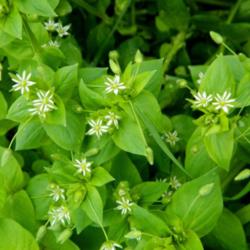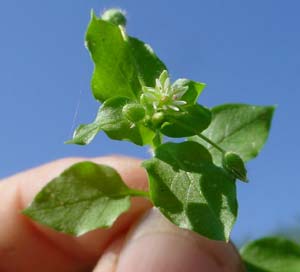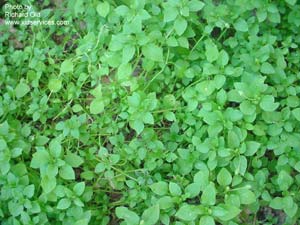

Chickweed (Stellaria media) is a widespread, hardy annual often found in moist, fertile garden soil. In mild winter climates it begins blooming before winter ends. Edible but not very tasty, chickweed plants form dense 3-inch-tall mats of foliage studded with starry white flowers. Control chickweed by pulling, which is easiest to do with the help of an old table fork. Dry plants in the sun before composting them. Mulching over vacant garden space in winter will reduce chickweed problems.
Weed Control TechniquesPulling. Most young weeds can be pulled from the soil. They will slide out most easily if you pull them when the soil is wet. Getting the root up is crucial, so think of the main stem as the root's handle, and grasp it as close to the soil line as you can. If you find that the weeds are breaking off at the crown as you pull, slip a kitchen fork, dandelion weeder, or similar tool under the weed, and pry and twist as you pull it up. Weeds that have taproots, such as dandelion and plantain, usually must be pried out. A flexible pair of waterproof gloves will keep your hands comfortable as you weed, and it's good to have a nice sitting pad, too. Let pulled weeds bake in the sun for a day or so before composting them. If pulled weeds are holding mature seeds, compost them separately in a hot, moist pile before using this compost in the garden.

Mulching. Mulch that's more than 2 inches thick can deprive most weed seeds of the light they need to germinate and grow. In vegetable and flower gardens, you can mulch with wheat straw (which has fewer weed seeds than hay), chopped leaves, grass clippings, or many other organic materials. Where weeds are numerous, try covering the soil with four to six sheets of newspaper. Then cover the newspapers with 2 to 3 inches of organic mulch. Pieces of scrap carpeting make a good weed-suppressing mulch to use in pathways between rows. When mulching beneath shrubs and trees, place a sheet of landscape fabric over the soil, then cover it with 3 inches of organic mulch. An edging (a 4- to 6-inch-wide strip of rot-proof material driven into the ground vertically) of brick, stone, or metal will help the mulch stay put, halt invasion by creeping weeds, and make the bed look neat and well groomed.
Image courtesy of Plant Stock Photos